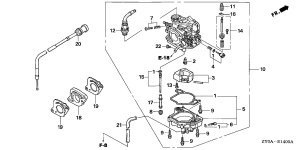Removing the recoil starter is "the book" method and you could do it that way if you so choose. But I think you will still find the intake housing will be in your way as you attempt to rotate the valve with the cable attached.
As to your question about what is attached to the valve or if there's a "suprise' waiting to jump out as you lift it out of the carb, the answer is no. Actually, the "valve", per se', is actually the end of the cable. The "valve" part is really nothing more than a guide for the cable. That's why the cable and "valve assembly" come mated together when you buy the valve. Because, without a cable, it isn't a valve at all.
You are correct, there is no "blade" in the carb throat to act as a choke. This system utilizes an "enrichment passage" that pulls additional fuel from the bowl to "fatten up" the mixture during cold start.
The little "barrel" at the end of the cable opens that passage when the cable is pulled and closes the passage when the cable is pushed in.
That's why the relationship between the housing, curved cable retainer boot and the carburetor housing is so critical. Any looseness will result in poor or no control of the enrichment system.
If the cable end isn't held firmly in the down or closed position, the mixture will always be rich and possibly too lean for cold start because there is looseness in the valve assembly.
If you choose to replace the cable only, I think you will find it frustrating and unsuccessful in the end. Believe me, I tried it a few times and used methods like trying shrink wrap to patch the boot and Loc-Tite to reinforce the threads. All with little to no success. I finally realized that replacing the whole assembly was the best way to go.
Your experience and deftness may get you a bettrr outcome but that's my opinion on this.
Good luck.



